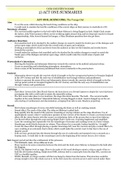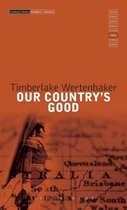OUR COUNTRY’S GOOD
2) ACT ONE SUMMARIES
ACT ONE, SCENE ONE; The Voyage Out
Aim:
- To set the scene whilst showing the harsh living conditions on the ship.
- I would want to emulate the horrific conditions of the convict ships on their journey to Australia in 1787.
Summary of scene:
- The convicts huddle together in the hold while Robert Sideway is being flogged on deck. Ralph Clark counts
the lashes; John Wise hammer reflects on the terrifying nights aboard ship and his desperate search for female
companionship; John Arscott lament his hunger; a Mary Brenham questions how she got there.
Audience Reaction:
- Feel unsettled and to be shocked by the sudden changes in sound to match the frantic pace of the dialogue and
action upon stage, which would evoke the overall sense of panic and confusion.
- Evoking an atmosphere of fear and terror from the audience as they see the brutality and cruelty shown
towards the convicts.
- I would make the audience feel unsettled and to be shocked by the sudden changes in sound to match the
frantic pace of the dialogue and action upon stage, which would evoke the overall sense of panic and
confusion.
Wertenbaker’s intensions:
- Showing the brutality and inhumane behaviour towards the convicts in the judicial and penal colony.
- Create an unsettling and intimidating atmosphere. atmosphere.
- Gives a sense of the monotonous punishment that occurs constantly in the penal system.
Context:
- Inhumanity shown towards the convicts which is brought on by the corrupt penal system in Georgian England
in the 18th Century and that the only way of rehabilitation was through violence and punishment.
- Achieve to present the sense of fear and inhumanity shown towards the convicts which is brought on by the
corrupt penal system in Georgian England in the 18th Century and that the only way of rehabilitation was
through violence and punishment.
==========================================================================
Lighting:
- Dark Blue/ Greens Gels (Dim Flood) Narrow the barn doors on a Fresnel lantern to depict the 'semi-darkness'
accompany this with a cold wash to mimic the miserable setting.
- The first scene takes place in two locations, the stage directions describe ‘The hold… The convicts huddle
together in the semi-darkness” Meanwhile Sideway is being flogged on deck. Lantern hanged up on the set;
extra feeling of confinement and disorientation, swinging from side to side. Shadows projecting.
Sound:
- Mid-volume soundscape of waves, forcefully battering the boats as well as creaking sounds.
- Sound effect; The crack of the whip. The whip on Slideway’s naked back.
- Snap quickly into the sound of the convicts screaming at varying volumes on the stage directions. Use of
quadraphonic sound, where I would place speakers in four corners of the theatre to create a surround sound
effect, fill the whole theatre with this sound, overwhelming. Echo of the groans that we hear from Sideway.
- Use Reverb effect through the actor paying Ralph Clark’s radio mic; Counting lengthened and amplified.
- Layer the counting lines repeatedly over the soundscape of screams and crashing waves at a lower volume.
- Soundscape would slowly decrease in volume. Then silence for 15 seconds, broken harshly by, ‘At night?’
- Create the Haas effect through placing a speaker downstage left, near the convicts and play a sound effect of a
wave crashing at an extremely loud volume which would make the convicts react in fear due to the use of
diegetic sound.
- Echo on lines, projected into the theatre through the use of a subwoofer and repeated every 3 seconds on a
looping track. I would fade in the soundscape used in the beginning of the extract but at a low volume.
Set: Suggest period and also the confinement of the prisoners.
- CYCLORAMA: Sails. All on different levels.
- There needs to be some connection between the deck and the hold, since Sideway is dumped in the hold after
his flogging.
- DECK; The highest level on stage. Floor to be made of old wood/decking to mimic a ship or made of lino to
look like old wooden decking. Ralph stood DSR, sideway tied to a mast/pole from the ship DSL, convicts sat
USC in a huddle together.
- HOLD; Beneath, is a large wooden raft that was hung by chains from the beams. This structure would be
strong enough to have the whole cast on it. In the first scene the convicts sat on it and it moved under them
, like a ship, rocking from side to side. The structure would be hoisted up high just below the decking to create a
low ceiling, emphasise the confinement.
-
Costume:
- The convicts; barely clothed in their London attire, or perhaps they have been fitted with sackcloth.
- The officer’s clothes may still be fairly fresh.
==========================================================================
Acting:
- RALPH; speaking in a barely audible, slow and monotonous voice to show that this is the daily norm for him.
He does not take pleasure in witnessing another man's pain.
- SIDEWAY; Sideway screaming on every stroke trying to be brave, just grunting perhaps drooping from the
wrists - he has passed out.
- CONVICTS; They can hear it, every whip they flinch and groan. Convicts wincing on each stroke, clearly
listening some oblivious and uncaring, some listening and aware.
- WISEHAMMER; Patriotism as John Wieshammer talks with nostalgia for England, linking the context of the
high amounts of prostitution in England in 1780s through sexual language with a hint of desperation 'take me
inside you, whoever you are.' Sitting cramped up on the floor, speaking out front to the audience with no
actions except his facial expressions.
- ARSCOTT;
- MARY;
, ACT ONE, SCENE TWO; A Lone Aboriginal Australian...
Aim:
- To re-inform the audience of the pre-existent colonization in Australia.
- However, the atmosphere of the extract should rapidly change in the transition between Scene one and two as
the audience observe the Aborigine.
Summary of scene:
- The Aborigine sees the First Fleet coming into Sydney Harbour and assumes it is a dream.
- Here we have the first introduction of the mysterious figure of the Aborigine. This symbolic character needs to
be differentiated from everybody and everything else from the start. He stands for Australia itself, so there
should be nothing too naturalistic about the way he is presented.
Audience Reaction:
Wertenbaker’s intensions:
- Wertenbaker’s intentions for this narrator-like character (a crucial part of the genre of Epic Theatre) was to
represent the native Australian community who initially observe the British colonies but later suffer from their
arrival.
Context:
==========================================================================
Lighting:
- Black out from the previous scene, allowing set to change.
- The Aborigine is watching from Sydney. The contrast between the light in the hold of the convict ship and the
Australian summer should be dramatic. Orange light (Fresnel) Use of spotlight.
- Shadows of trees in a Gobo. Over a straw yellow wash. Birdies highlighting the aborigine from below to make
him stand out more. A sun beams. A big sense of patriotism.
Sound:
- Native birds and wildlife.
- The sounds of native Australian instruments such as the digeridoo
- On the motivated action of the Aborigine entering the stage from upstage right, I would increase the volume of
the instrumental noise.
- I would also have a recording of the stage directions, ‘A lone Aboriginal Australian…January 20, 1788’ which
would be layered at a soft tone and repeated on a loop over the digeridoo.
- I would use an extreme reverb effect on the radio mic of the Aborigine on the line, ‘a giant canoe drifts onto
the sea’ which would distort the words and the loud volume would create a sense of fear and unknowing for
the audience. At the end of the extract, I would have the heightened soundscape snap quickly into silence, with
the faint sound of birds chirping to transition to the next scene.
- Sounds of civilization muttering in the distance. Slight sounds of a crowd talking and infrastructure being
built.
- Kookaburra sounds
- Crashing waves
- Initially, I would decrease the volume of the waves and screams and then layer at a very low tone and low
volume over the withstanding soundscape, creating the effect of foreboding and nervousness. This would add
to the total dramatic effectiveness as it would be played through the quadraphonic sound system and it would
be non-diegetic, so the audience feel direct fear and anxiety.
Set:
- Use of a protruding level or rostra to allow smooth transition of scenes.
- Cyclorama: Fades to tree background.
- Ledge that looked like a cliff face up stage, to show that the Aboriginal was in a different scene, it would be a
quick and swift entry and exit and to show that he had lived there for a long time and knew the part he was
living well. He would also be raised to create more interesting levels, to create his role as a bit of a narrator
and so it could be used in later scenes.
- Hydraulics. A podium shaped like a cliff, with surrounding podiums for him to jump onto. This would
demonstrate his familiarity with his native country. We would have these cliffs on hydraulics coming up form
center stage. He could climb the cliff as its rising.
Costume:
Fish Oil, the aborigine would cover themselves as protection from insects.
Traditional tribal headpiece with war paint on his face. Hessian material worn around his waist. Bare-foot.





